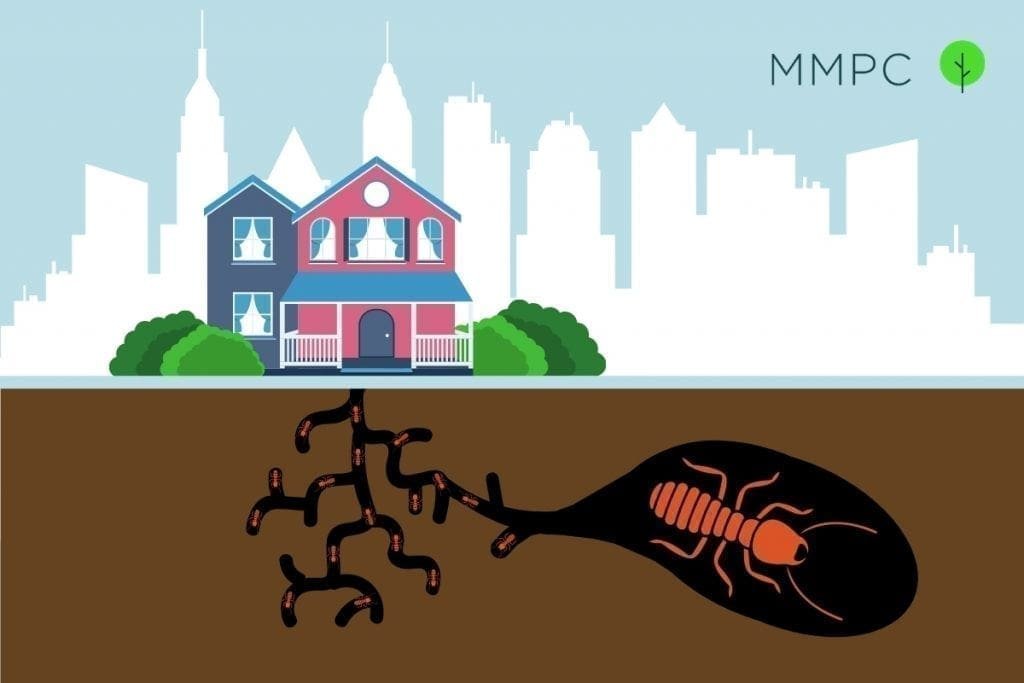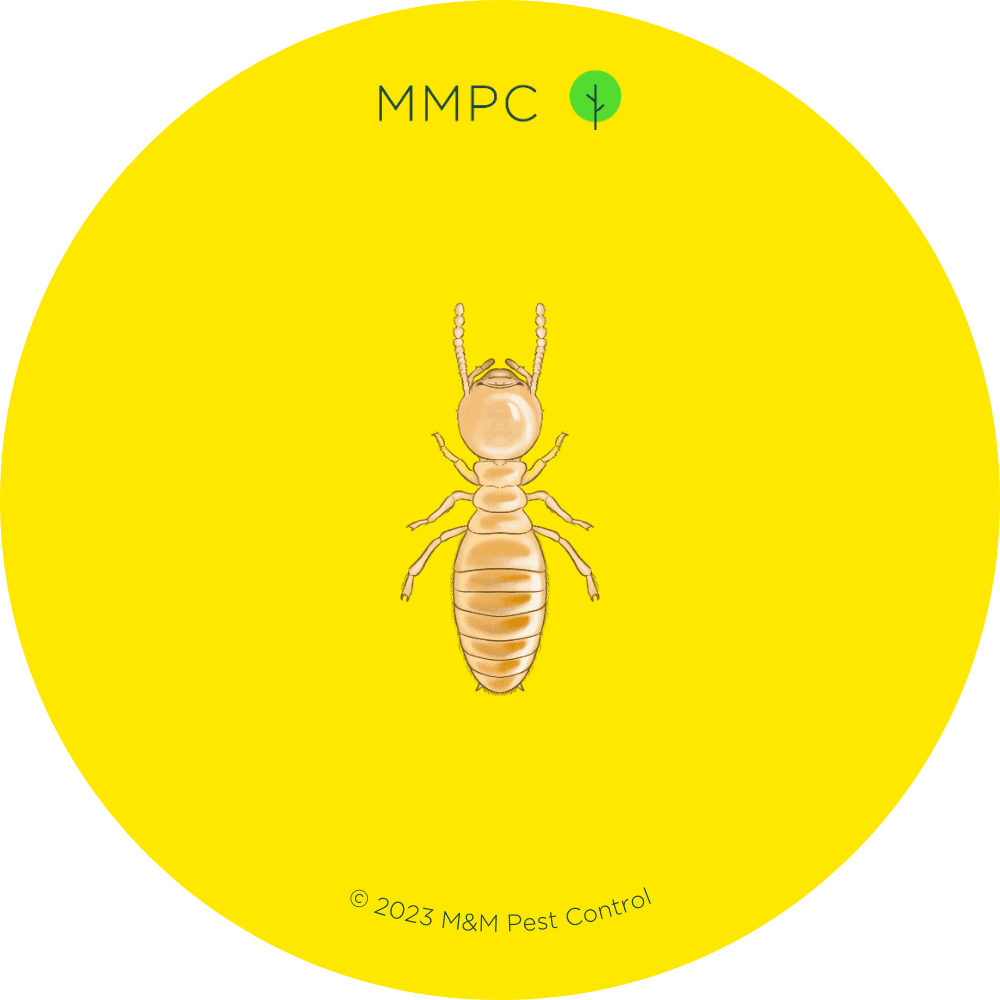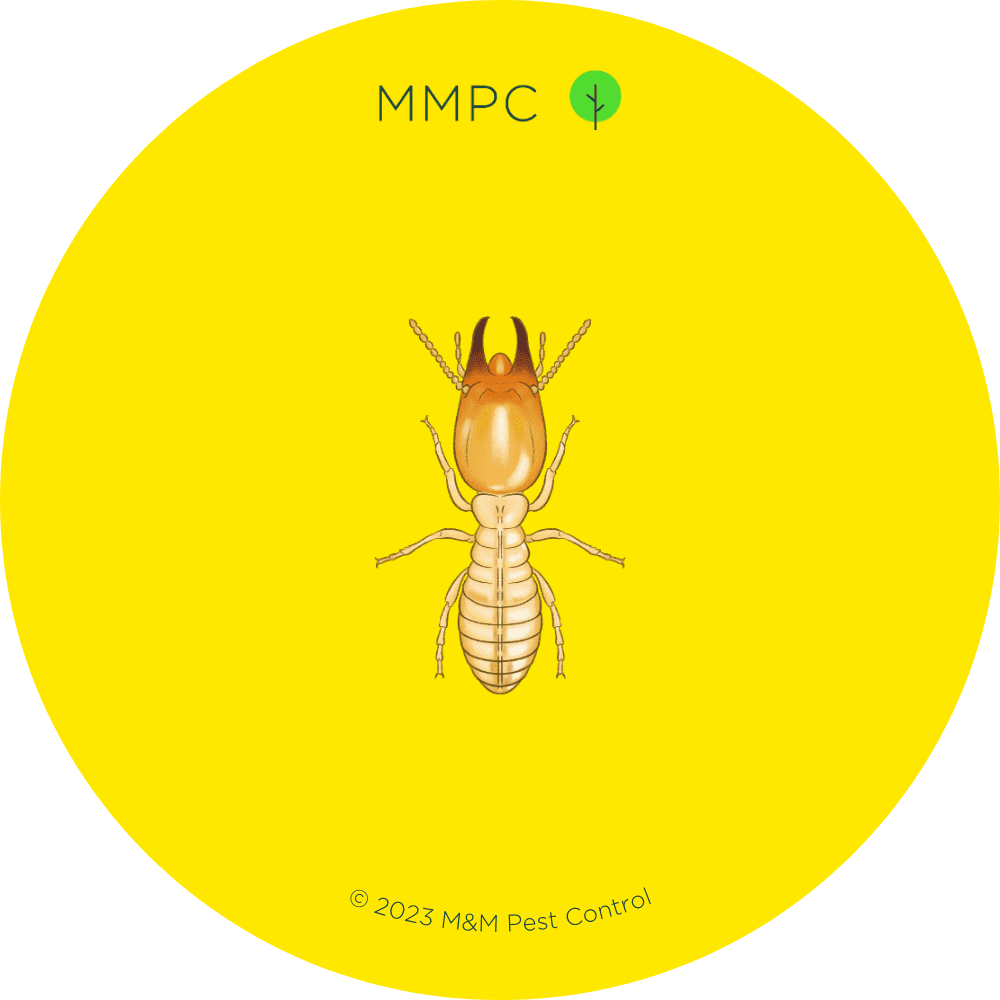
Termites might be small, but they are one of the most destructive and expensive pests for homeowners in New York City. Each year, termites invade approximately 600,000 homes in the United States, causing $5 billion in structural damage and termite control costs.
One of the reasons why termites cause so much damage is that they stay out of sight and are hard to detect. By the time a homeowner or landlord finally discovers signs of termites, the infestation has often already caused significant damage.
Here’s what you need to know about dealing with termites and termite swarmers in New York City, including facts, prevention, control, and extermination.
MMPC Termite Guide:
Facts about Termites
Termites are highly destructive insects that feed on cellulose-rich materials, especially wood. They are small, saw-toothed insects that are often mistaken for ants due to their similar size and color.
The five main types of termites found in the United States are subterranean, drywood, dampwood, Formosan, and conehead termites.
In New York, eastern subterranean termites are the most common type of termite. They thrive in dark and moist environments with plenty of cellulose-rich materials to feed on. These termites build their colonies in soil and emerge in the spring to search for new food sources.
Termites live in highly organized colonies with a hierarchal caste system consisting of workers, soldiers, and reproductive termites, which include a queen, king, and alates (or swarmers).
- Worker termites are responsible for searching and collecting food, as well as building mud tubes and maintaining the nest.
- Soldier termites protect the colony from predators. They are larger than workers, with darker heads and larger mandibles.
- Alates (swarmers) are winged termites that are produced once a termite colony has matured. Their primary mission is to find new mates and establish new colonies.
- Queen termites can grow to be 4 to 6 inches in length, which is about the size of a finger. A subterranean termite colony’s queen can live up to 30 years and produce thousands of eggs each day.
- King termites are the same size as an average worker, and together with the queen, they release pheromones to maintain order within the colony’s caste system.
More Termite Facts
- A mature termite colony can house between 60,000 to 1 million termites.
- Subterranean termite colonies mature in about 6 to 7 years, after which swarmers are produced and leave the colony to find new mates.
- Termite swarmers are poor fliers and typically travel no more than 300 feet away from their original colony.
- Surprisingly, two of New York’s most detested types of pests evolved from a common ancestor; termites belong to the same order as cockroaches (Blattodea).
- There are over 2750 species of termites around the world, and they play an important role in many ecosystems by breaking down dead wood and returning nutrients to the soil.
- Termites have the ability to eat wood, but they can’t digest it without the help of symbiotic microorganisms that live in their gut.
- Some termite species have the ability to cultivate fungi as a food source, and they have even been known to use antibiotics to protect their fungal gardens from harmful bacteria.
- Termites never sleep. They’re constantly eating and working 24/7, which is one of the reasons why these pests are so destructive—no rest for the wicked!
Problems Caused by Termites
Although termites do not bite, sting, or carry disease, their presence can cause various problems in your home. Termites mainly consume materials rich in cellulose, such as wood, but they can also chew through other types building materials in search of new food sources.
Structural Damage
When it comes to termites, the main concern that most homeowners have is the damage they can cause to the structure of their homes.
Subterranean termite colonies can go undetected for years, causing significant structural damage over time. The average termite colony consumes around 5 grams of wood per day (this varies based on the size of its population).
Damage to wooden structural elements in your home can lead to problems such as foundation issues, cracked walls, and warped doors and windows. In extreme cases, a severe termite infestation can cause a home or building to collapse entirely.
Here’s an article about what termite damage looks like.
Electrical and Heating Problems
While wood is the primary target of termites, they can also chew through other materials to get to it. Along the way, termites may cause damage to electrical wiring, cables, and insulation, posing a potential safety hazard and leading to costly electrical and heating problems.
Mold
Termites don’t directly cause mold, but their presence in a home can create conditions that promote mold growth.
As termites consume wood and other cellulose-based materials, they produce moisture from the digestion process. This moisture accumulates in areas of the home with poor ventilation, leading to a buildup of moisture and humidity. This creates an ideal environment for mold spores to grow and spread.
In addition, structural damage caused by termites might also allow rainwater to seep into the affected areas, further promoting mold growth.
Signs of Termites
Although they are usually hard to detect, termites will leave clues in and around your home. Recognizing these signs of termites can help you decide when to schedule an annual termite inspection or contact a termite control professional.
1. Stuck Windows or Doors
Termite damage causes windows and door frames to warp, making it difficult to open and close them.
2. Mud Tubes
These vein-like structures resembling thick lines of dried mud can be found along the sides of your home or other structures near areas with exposed wood. They function as external tunnels that allow termites to travel between food sources and their colonies.
3. Termite Swarmers
Finding swarmers in your home is a telltale sign of a termite problem.
Swarmers are winged reproductive termites that resemble flying ants. They emerge in the spring and, since they’re attracted to light, you typically find them in large numbers around doors and windows.
Other Signs of Termites
- Maze-like patterns on wooden surfaces
- Damaged wood
- Tiny holes in walls
- Discolored drywall
- Peeling paint
- Buckling or squeaky floorboards
- Loose tiles
How to Prevent Termites
An ounce of prevention is worth a pound of cure. This is especially true when it comes to termites, which can cause damage to a property for a long time without being noticed.
Here are some ways to help protect your home from termites.
- Regularly inspect your home for signs of termites, such as damaged or hollow wood, bubbling paint, mud tubes, and stuck doors or windows. Getting an annual termite inspection is recommended, especially if you live in an area with high termite activity.
- Wood can also be treated with borate to prevent termites. Borate is a low toxicity chemical that both preserves and protects treated wood by acting as a barrier to termites. This is an effective method of prevention typically done during the construction of a new house or structure.
- Seal any structural cracks or crevices in the walls or foundation of the interior and exterior of your building.
- Keep your home dry by diverting rainwater away from your home and promptly repairing any leaks or plumbing issues. Make sure basements and crawlspaces are also dry and free of clutter.
- Replace damp or damaged wood on the exterior of your home, including your porch and storage areas.
- Keep firewood above ground and covered so it can stay dry, and be sure to inspect it before bringing it inside your home.
- Remove dead trees, stumps, and roots near your home.
Solutions to Get Rid of Termites
There are several types of treatments for termites, depending on the size and severity of the problem:
- Soil and barrier treatments
- Baiting
- Fumigation
Termites are not a do-it-yourself kind of pest problem. If you know you have termites, it’s a good idea to contact a termite control professional as soon as possible.
Soil and Barrier Treatments
Soil treatments involve applying liquid termiticides to the soil underneath or around the foundation of a building, creating a chemical barrier that protects the exterior of your home and stops termites from tunneling through.
Other barrier treatments include injecting foam termiticides into walls and floors or installing termite shields around wooden structural elements.
Depending on your situation, these methods may be combined to simultaneously stop existing termites while also preventing future infestations.
Baiting
Termite bait treated with low doses of slow-acting termiticides can be used to provide long-term termite control.
Worker termites bring poisoned bait from bait stations back to their nest, eventually poisoning the entire colony and eliminating the problem at its source.
Fumigation
Fumigation involves enclosing a severely-infested area with sulfuryl fluoride gas (Vikane) to exterminate any termites inside.
The treated structure or area is typically tented and sealed for up to three days, but this may vary depending on the size and severity of the termite infestation.
About MMPC: NYC’s Top-Rated Termite Control Experts
At MMPC, we have 25+ years of experience helping our clients diagnose and treat termite infestations in New York City and the surrounding areas.
Read more about our termite control services here.
If you have questions about termites, or would like to schedule a termite inspection or treatment, call (212) 219-8218 or fill out our termite contact form.



